12.04.12
Posted in Non-US Weather, Tropical Weather, Weather News at 4:52 pm by Rebekah
Yesterday I posted about Typhoon Bopha and its proximity to the equator. Bopha went on to strengthen to the equivalent of a Category 5 on the Saffir-Simpson Scale, and made landfall in the Southern Philippines as a Super Typhoon with maximum sustained winds of 160 mph.
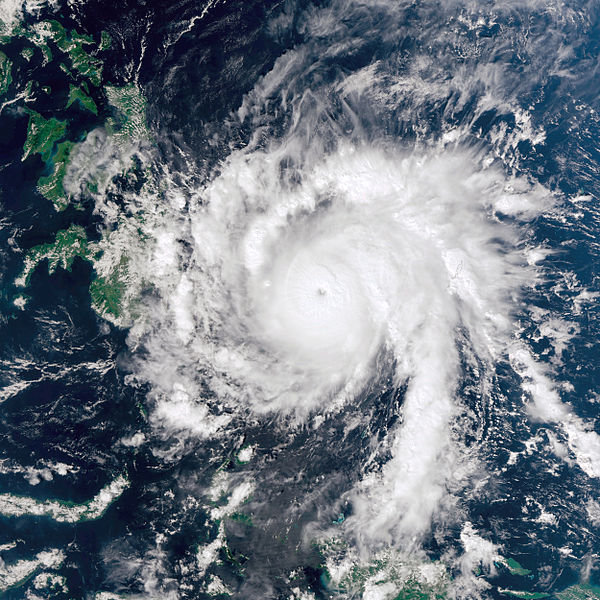
NASA image of Super Typhoon Bopha just prior to landfall in the Philippines. From Wikipedia.
To quote again from an article on The Weather Channel’s website:
“Dating to 1945, there have been only 4 other typhoons that have tracked within 200 nautical miles of Davao, Philippines (on Mindanao Island) with an intensity of at least a category-four storm, including Mike (“Ruping”) above:
- Mike “Ruping” (1990)
- Ike “Nitang” (1984)
- Kate “Titang” (1970)
- Louise:Marge “Ining” (1964)
Only “Ruping” and “Ining” were the equivalent of category-five storms.”
Furthermore, the article cites Dr. Jeff Masters of Weather Underground saying Bopha formed closer to the equator (at 3.8°N) than any other tropical cyclone on record, and nearly became the closest to the equator Category 5 storm (at 7.4°N). Only Super Typhoon Louise in 1964 was closer at Category 5 strength, at 7.3°N.
Permalink
12.03.12
Posted in Non-US Weather, Tropical Weather, Weather Education, Weather News at 5:09 pm by Rebekah
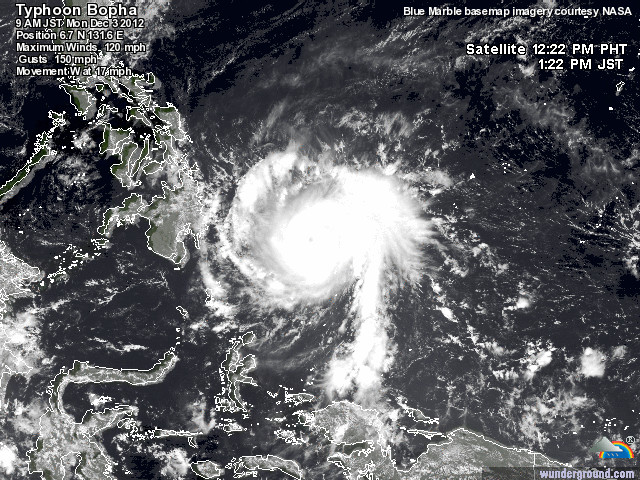
Typhoon Bopha narrowly missed Palau last night on its westward track through the west central Pacific. The typhoon has weakened slightly from the equivalent of a Category 4 on the Saffir-Simpson Scale to a Category 3 as it makes its way towards the southern Philippines.
It is unusual for a strong typhoon to exist so close to the equator; a recent article from The Weather Channel points out that Bopha is the strongest typhoon to track through the southern Philippines in 22 years.
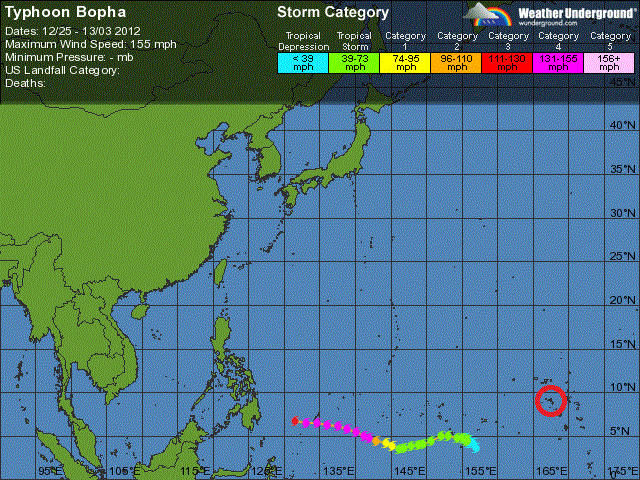
Bopha’s history (above) and 5-day forecast (below); Kwajalein Atoll (where I live) is circled in red. All images courtesy of Weather Underground.
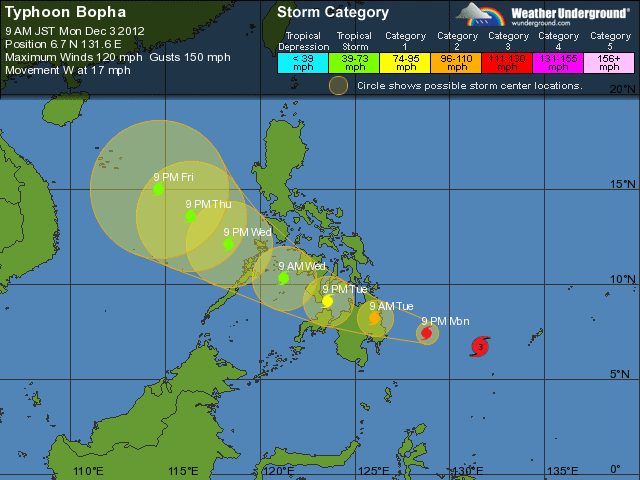
But why is this unusual? Put simply, tropical cyclones require a certain amount of rotation to be able to strengthen. You probably know that wind in the Northern Hemisphere is deflected one way, while wind in the Southern Hemisphere is deflected the other way–this is known as the Coriolis force.
The closer you are to the poles, the stronger the deflection; which means the closer you are to the equator, the less the wind favors deflecting one way or the other. Even if you have all the other necessary “ingredients” for a tropical cyclone to form, if the trough of low pressure does not start to rotate, or does not rotate very much, the central pressure will fail to deepen and the wind speeds will not increase very much (remember, the stronger the pressure gradient, the stronger the winds as the atmosphere tries to balance out the pressure differences — see Meteorology 101: Elements of Weather – Wind).
Generally you will not see tropical cyclones forming between about 5°N and 5°S, let alone strengthening to Category 4 storms. This is why here at Kwajalein, at 8°N, we don’t expect we could get much more than the equivalent of a Category 2. Many tropical cyclones form near the Marshall Islands, but in order to get a stronger storm tracking through, it would need to form further upstream and closer to the equator, which is possible but not very common.
See also one of my previous posts on how tropical cyclones form: Tropical Cyclones: How They Form, Move, and Strengthen (aka, What Danielle, Earl, and Frank Are Up To) – Part 1
Permalink
12.02.12
Posted in Non-US Weather, Tropical Weather, Weather News at 5:16 pm by Rebekah
Here on an island with dial-up Internet at home and no cell phone service it can be hard to feel connected with the rest of the world sometimes.
However, even in an area with some of the least interesting (but perhaps most pleasant) weather in the world, you can still find global atmospheric connections.
Yesterday Kwajalein received 4.17 inches of rain. That’s not too unusual, but it’s still a pretty rainy day. The Christmas tree lightning and ceremony had to be postponed for a couple of days.
Meanwhile, my parents in the Pacific Northwest tell me that parts of the West Coast have been receiving good amounts of rain and snow due to “atmospheric rivers”. A while back I wrote a post on rivers of moisture, specifically the Pineapple Express (transporting atmospheric moisture from the tropical Pacific to the West Coast of the US) and the Rum Runner (tropical Atlantic to the UK and western Europe).
The following map (click to enlarge; from this precipitable water loop) shows the next moisture plume headed for the West Coast (green to yellow shading), and as you can see, most of that moisture can be traced back to Hawaii and points southwest of there. Kwajalein lies at about 8N, 167E, which on this map is in the middle of an orange band of juicy atmospheric moisture. Most of our moisture comes from the east and goes towards the west as we’re in the tropics, but it’s kind of cool for me to think that the moisture from all of our rain yesterday had pretty much the same source as the moisture headed towards my family.
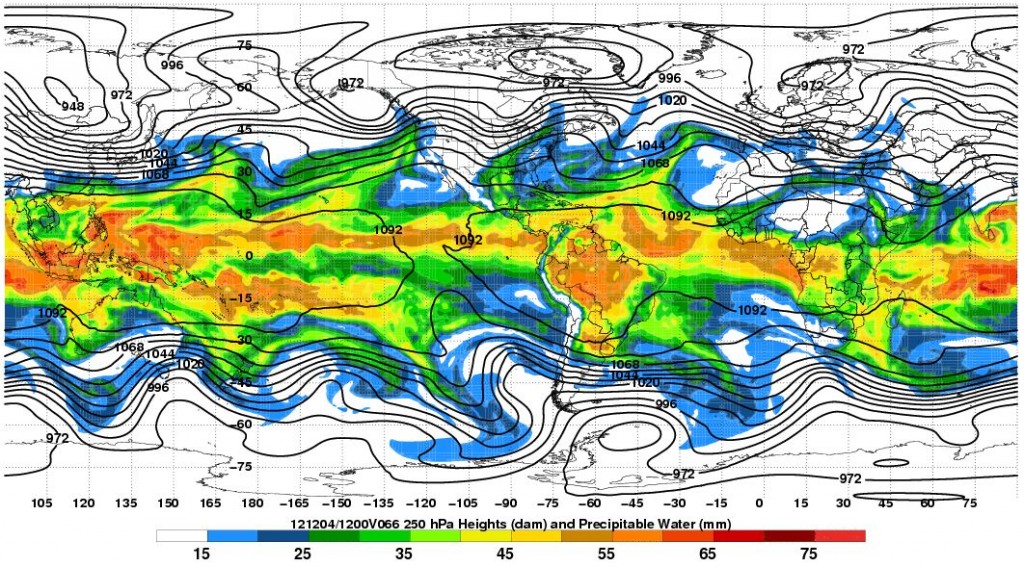
This MTSAT infrared satellite image shows the picture in a different way, with a band of clouds marching westward through the tropics and a band of clouds streaming northeastward from the tropics through Hawaii and on to the West Coast. This is one of many conveyor belts through the atmosphere that works to balance out an aspect of weather, in this case transferring warm, moist air from the tropics towards the poles!
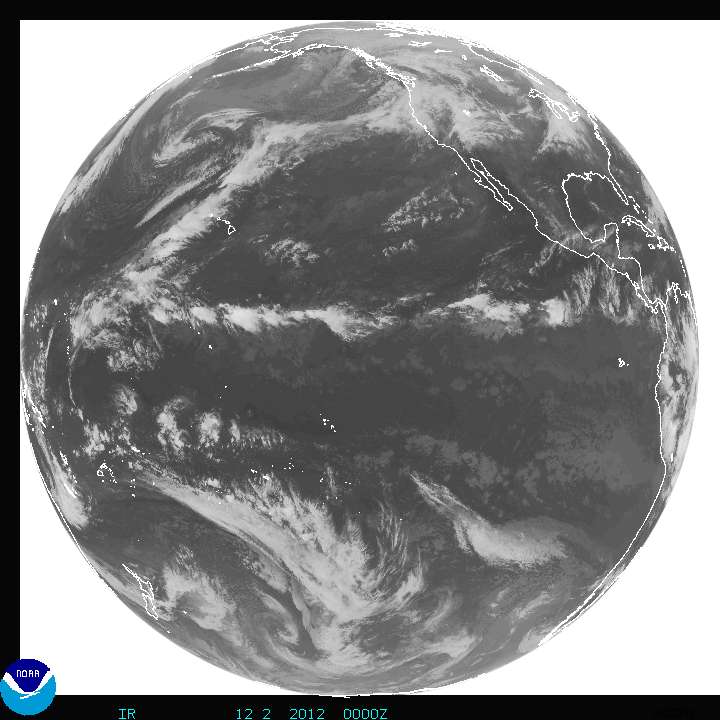
Permalink
05.10.11
Posted in Non-US Weather, Tropical Weather, Weather News at 8:00 am by Rebekah
This week’s post in the global weather and climate series features Kwajalein Island, part of the Kwajalein Atoll of the Republic of the Marshall Islands (click for a Yahoo! maps link).
You may know by now that I recently accepted a job offer to work as a forecaster on Kwaj, as the locals call it. I’ll write a lot more about the island later, of course (see my new Kwaj blog here), but I thought I’d do a feature post on Kwaj before I even get there.
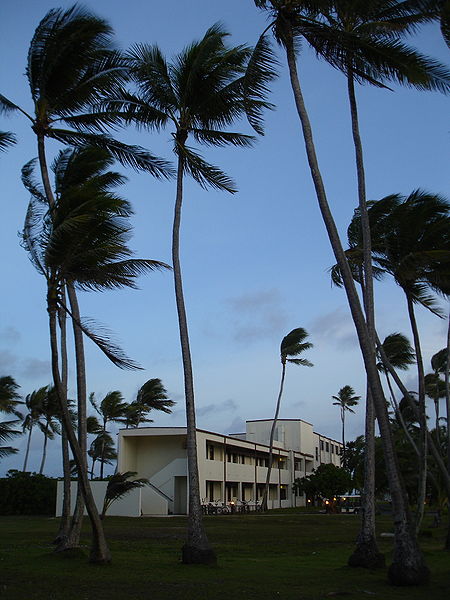
The Kwaj Lodge, for short-term housing but typical of housing on the island. From Wikipedia
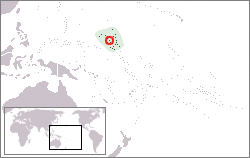
Map showing the location of Kwajalein Atoll, from Wikipedia
Kwajalein Island is a small island on the southern end of the Kwajalein Atoll. An atoll is a series of islands on a coral reef that surrounds a lagoon. Again, I’ll write more on all of this later.
Kwajalein Atoll is part of the Republic of the Marshall Islands, although Kwajalein Island is a U.S. Army base so there really are no locals on this island. The Marshall Islands are way out in the Pacific, and Kwajalein is just north of the equator and just west of the International Date Line.
Kwajalein has a long history, but in short, the Marshall Islands are Micronesian and were taken over by the Japanese some time in the early 1900s. The U.S. fought over (and won) Kwajalein during World War II, and today the island is an army missile testing site (from what I understand the island is sort-of “rented” out to the U.S., although there is much more to it than that).
A few more facts about Kwajalein (weather data from the RTS Weather Station, where I’ll be working):
- Time zone: UTC + 12
- Elevation: near sea level
- Climate zone: Tropical marine
- Average high temperature: 87 °F (30 °C)
- Average low temperature: 78 °F (25 °C)
- Average annual high/low temperature range: 86 to 87 °F (30 to 31 °C) / 78 °F (25 to 26 °C)
- Record high temperature: 97 °F (36 °C)
- Record low temperature: 68 °F (20 °C)
- Average annual rainfall: 80 inches (2,030 mm)
Weather: As you can tell by the statistics, Kwajalein does not have much of a temperature range; the island is typically warm and humid, and I hear there are two seasons: warm and wet, and warm and windy (trade winds).
I look forward to learning a lot more about the tropical weather of Kwajalein before and during my time there. I do know that the island is too close to the equator to get strong typhoons (tropical cyclones), although they may occasionally get sideswiped by weaker cyclones.
As to the weather this week…I’ll guess that highs will be around 86 °F and there may be a chance of thunderstorms! (Check the forecast…yep, that’s about right! Though I know there will be more to my job than just that… 🙂 )
For weather maps and information on current and forecast Kwajalein weather, see the RTS Weather Station, Weather Underground and Weather Online UK (global maps and models).
Here’s a Wikipedia link for Kwajalein Atoll, and here’s a Wikipedia link for the Republic of the Marshall Islands.
Next Tuesday I plan to take a look at the climate and weather in another part of the globe, hopefully just after witnessing a space shuttle launch! As always, if you have any suggestions for future cities, please leave a comment!
Follow Green Sky Chaser on Twitter and Facebook for weather, chasing, and blog updates.
Permalink
02.19.11
Posted in Non-US Weather, Tropical Weather, Weather News at 8:00 am by Rebekah
Ex-Tropical Cyclone Carlos just keeps on dancing down the northwestern coast of Australia!
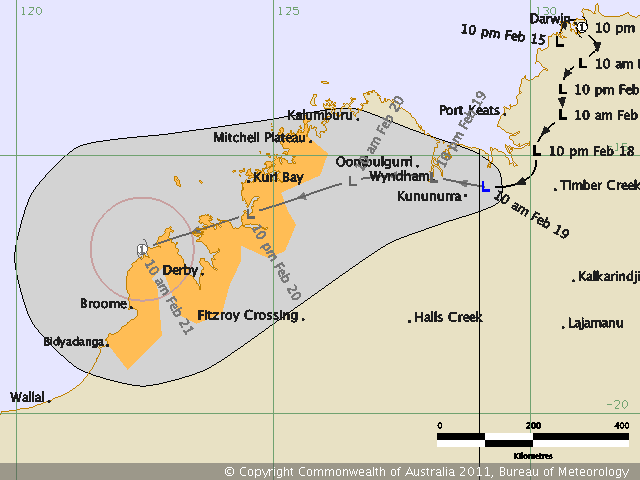
This is so strange…the tropical low was upgraded to tropical cyclone as soon as it moved OFF the coast (would that be a…waterfall? :)), then it came back onshore, swirled around Darwin and dumped over 2 feet of rain on the area in about 3 days (over half the average February rainfall). Now it’s still being recognized as a tropical low. Carlos is close to making it offshore again, but really has the best chance in a couple of days, when the low could become a Category 1 cyclone again.
Oh, and in the meantime, Category 3, Severe Tropical Cyclone Dianne is off the west coast of Australia, actually acting more in character for a tropical cyclone (well, except for the couple of little loop-de-loops the Bureau of Meteorology had her taking). Dianne isn’t expected to make landfall, but to gradually weaken.
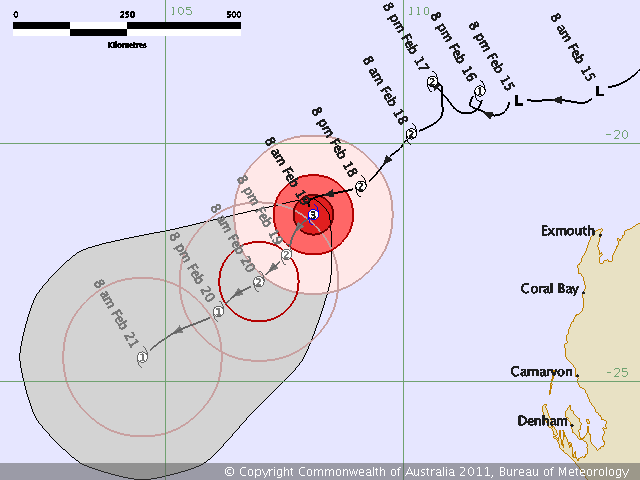
Follow Green Sky Chaser on Twitter and Facebook for weather, chasing, and blog updates.
EDIT: The Bureau of Meteorology now has Carlos getting to a Category 2!
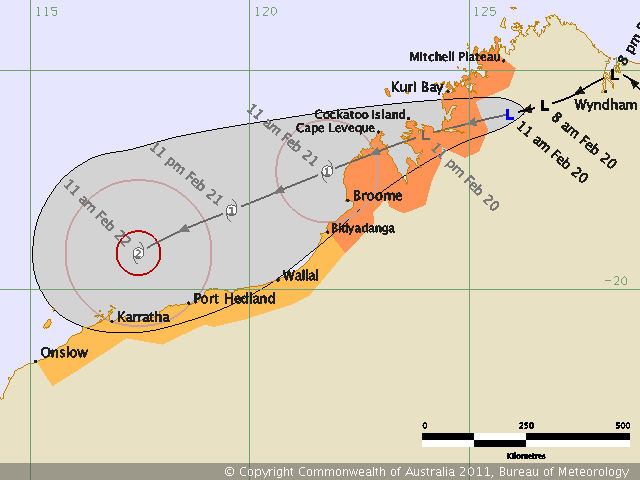
Permalink
« Previous entries Next Page » Next Page »










